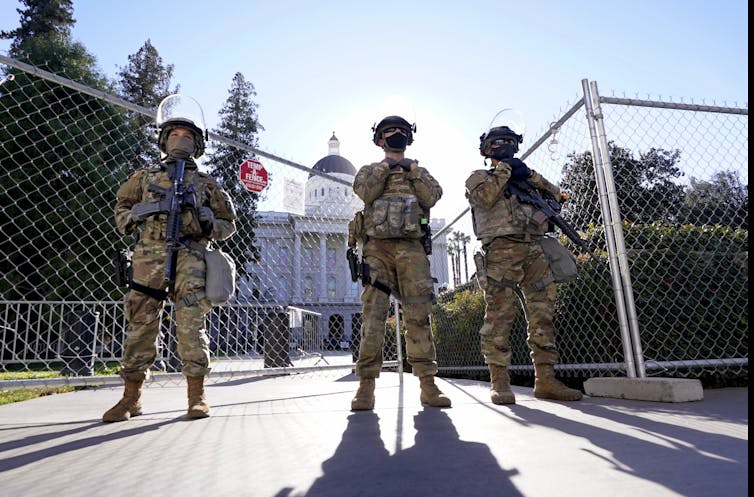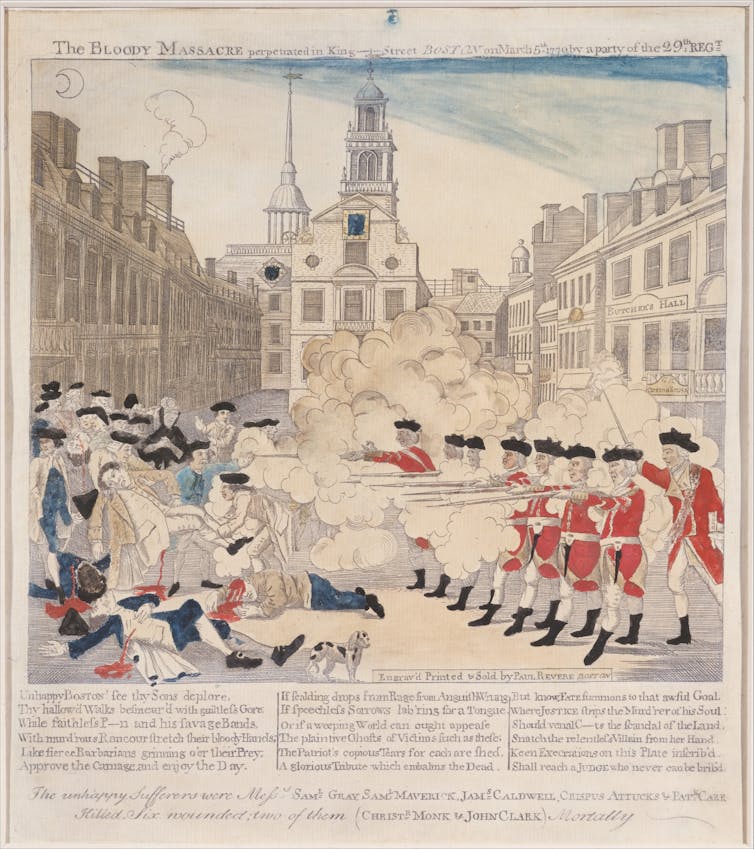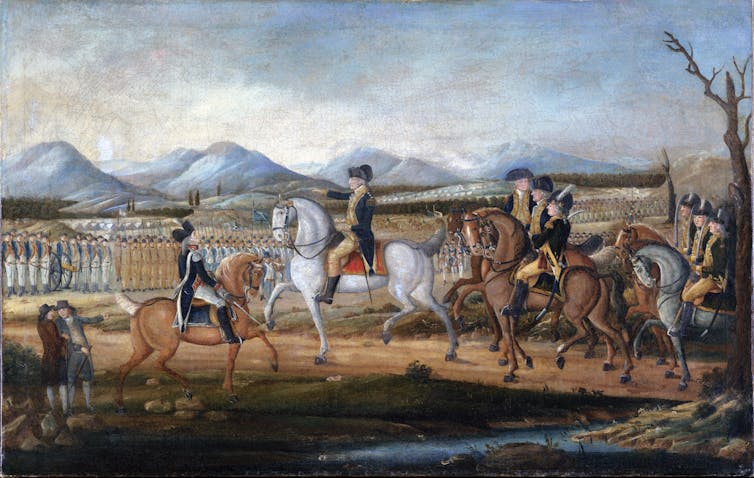In most states - even Texas and, yes, Rhode Island - armed private militias are illegal
Eliga Gould, University of New Hampshire
 |
| The Second Amendment declares the importance of state-government authorized militias, like these National Guard troops guarding the California State Capitol building. AP Photo/Rich Pedroncelli |
The ruling, by U.S. District Court Judge Roger Benitez, does not take effect immediately, because California has 30 days to appeal the rejection of its assault weapons ban.
Most coverage has focused on Benitez’s provocative analogy between an AR-15 and a Swiss army knife. But the case raises troubling questions about the meaning and proper role of “militias” under the Second Amendment.
The plaintiffs in the lawsuit claimed that California’s assault weapons ban unconstitutionally restricted citizens’ Second Amendment rights by preventing them from using assault weapons for home defense and other legal purposes. California’s defense was that assault weapons are more dangerous than other firearms and therefore subject to additional restrictions.
In his ruling, Benitez asserts that citizens have a right to own a private assault weapon not just for defense of a gun owner’s home, but also for “citizens’ militias” engaged in homeland defense.
If the founders were alive today, I believe they would be very concerned – because the Constitution is clear that the only militias protected by the Second Amendment are “well-regulated” units authorized and controlled by state governments, not a private citizen militia.
 |
| These armed, camouflage-clad people at a protest in 2021 say they are part of a militia group, but not one sponsored by a state government. Joseph Prezioso/AFP via Getty Images |
Starting from a precedent
The preamble to the Second Amendment mentions service in a militia as a reason citizens have the right to keep and bear arms: “A well regulated Militia, being necessary to the security of a free State, the right of the people to keep and bear Arms shall not be infringed.”
In his ruling, Benitez builds on the 2008 Supreme Court case D.C. v. Heller. In that landmark case, the Supreme Court held, as Justice Antonin Scalia wrote, that the amendment protects a right to possess a firearm unconnected to military service and that individuals are free to use such weapons for “traditionally lawful purposes, such as self-defense within the home.”
Benitez accepts this individual right, including to own assault weapons, but he adds what he calls “citizen militias” to the mix, which he defines as an “informal assembly of able-bodied, ordinary citizens acting in concert for the security of our nation.” The AR-15, he says, is an “ideal arm” for such purposes.
While distinguishing a citizen militia from a “state-organized militia,” the judge is vague about what, exactly, a citizen militia is. The examples he offers include the armed partisans led by Fidel Castro, Ho Chi Minh, and the Taliban and Iraqi insurgents.
Although Benitez surely knows that the United States has a long history of vigilantism and mob violence, he doesn’t say which informal groups of armed citizens in this country might qualify and which would not.
That lack of specificity is a problem. Does a citizen militia include the protesters who occupied the Michigan State Capitol during the spring of 2020, posing with assault weapons slung over their shoulders?
What about the activists who in the summer of 2020 briefly created Seattle’s Capitol Hill autonomous zone, where guards armed with AR-15s stood watch at the entrance and patrolled the streets?
Kyle Rittenhouse, on trial for killing two people with a Smith & Wesson rifle in Kenosha, Wisconsin, allegedly viewed himself as part of a militia and claimed to be helping the police.
Government-authorized groups only
The biggest problem with Benitez’s ruling is that the Second Amendment sanctions a “well-regulated militia,” not an informal assembly of armed citizens. As the founders knew, a “well-regulated militia” was one authorized, trained and – with growing frequency during the American Revolution – armed and provisioned by state governments.
After the American Revolution, the purpose of these state militias was clearly laid out in Article I, Section 8, Clause 15 of the Constitution: so Congress could use them to “execute the laws of the union, suppress insurrections, and repel invasions.”
Today, the militia in all 50 states is the National Guard. In California, as Benitez notes in his opinion, the militia also includes the State Guard, a force trained and equipped by the government. There is nothing informal about it.

Avoiding mob rule
Having lived through the Revolutionary War, the founders knew why the words “well regulated” mattered. They had seen what happened when people took the law into their own hands.
After the Boston Massacre in 1770, when British soldiers opened fire on a crowd that had been pelting them with rocks and ice, John Adams defended the soldiers during their murder trial, worried that a guilty verdict could lead to mob rule.
In 1775, the Colonial Minutemen who stood their ground at Lexington and Concord served in units authorized by the Massachusetts legislature. Although taking up arms against their king and his soldiers, they fought as members of a well-regulated militia.
 |
| President George Washington, at center on white horse, reviews troops in Maryland before marching to suppress the Whiskey Rebellion. Metropolitan Museum of Art, via Wikimedia Commons |
President George Washington responded in 1794 by marching west at the head of 12,950 federalized state militiamen. By the time the Western Army reached the Ohio River, most of the rebels had gone home. The nation’s first president made clear that in a democratic republic, the way to make your voice heard is through the ballot box, not the muzzle of a gun.
The right to own a gun is “not unlimited,” as Justice Scalia wrote in 2008. For that reason, the Supreme Court held that state and federal authorities can bar firearms from schools and public buildings, while the people remain free to prohibit what Scalia called “dangerous and unusual weapons.”
The AR-15 may no longer be unusual, but California’s decision to appeal Benitez’s ruling shows that the state still thinks it is dangerous. If the rifle really is Benitez’s “ideal” weapon for a citizen militia, then perhaps the state is right.
[Insight, in your inbox each day. You can get it with The Conversation’s email newsletter.]![]()
Eliga Gould, Professor of History, University of New Hampshire
This article is republished from The Conversation under a Creative Commons license. Read the original article.